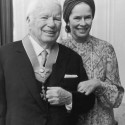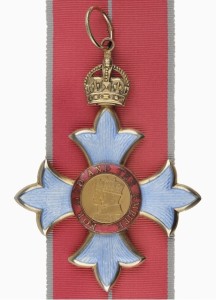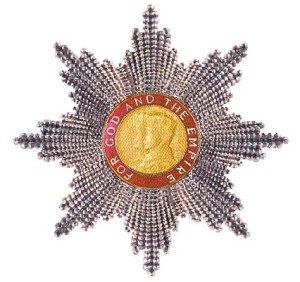A Scion Society of The Baker Street Irregulars

Charlie Chaplin Honored as Knight of the British Empire
“… Holmes refused a knighthood …”
– The Adventure of The Three Garridebs (3GAR)

As we learned in Peter Jacoby’s recent post, Charlie Chaplin role as Billy the Page in William Gillette’s Sherlock Holmes laid the foundation for his future career in the theater and movies. Chaplin would go on to great fame and receive many honors over the years. One honor that eluded Chaplin for many years was that of being included on the Honours list by the British monarch. This was eventually corrected in 1973.
We learned from a July 2, 2002 report by Paul Reynolds of BBC News Online that efforts to have Chaplin honored were blocked by some British government officials for nearly 20 years, starting in the early 1950’s:
Confidential Foreign Office papers just released by the Public Record Office reveal how for years Charlie Chaplin was denied a knighthood.
The papers are being put on the Record Office website from Monday, 22 July, 2002.
They include a hostile report on Chaplin by the Foreign Office research department in 1956.
This drew attention to his “communist” sympathies and to his morals – his marriages included two to girls aged sixteen and he had once lost a paternity suit.
It wasn’t until 1971 that an official remarked that “a good deal of water has flowed under the bridge since then” and that “there may be a feeling that it is time to let bygones be bygones”.
Chaplin was eventually knighted in 1975. It wasn’t until 1971 that an official remarked that “a good deal of water has flowed under the bridge since then” and that “there may be a feeling that it is time to let bygones be bygones”.
The episode shows the deep sensitivity of the issue, with views being sought from the British ambassadors in Washington and Switzerland (where Chaplin, still a British citizen, moved to in 1952 after leaving the United States).
The damning research department memorandum is headed The United States’ case against Mr Charles S Chaplin.
‘Lurid’ paternity suit
Indeed much of the British reluctance to give Charlie Chaplin a knighthood stemmed from concern that the Americans, then in strong anti-communist mood, would not approve and the British honours system would therefore be “brought into disrepute”.
The memo says: “Mr Chaplin has alienated many of his former champions and admirers by allowing himself to be played up in certain European countries as a martyr to “hyper-Americanism”.
He has also added grist to his opponents’ mill by his acceptance of public marks of favour from the communist orbit – e.g. his consenting to receive the “peace prize” of the communist-sponsored World Peace Council in June 1954″.
So keen was one official to point out the supposed moral lapse in his marriages that in another document the phrase “16-year-old women” was changed.The report points out: “Mr Chaplin managed to shock even the more broad-minded in the 1920s – e.g. his two marriages to 16-year-olds. Nor has the press allowed its readers to forget the Joan Barry paternity suit, the lurid details of which dominated headlines in 1943 and 1944 before Mr Chaplin was finally declared the legal father of Miss Barry’s child.”
The word “women” was crossed out and “girls” written in by hand.
In 1969, the Foreign Office still opposed a knighthood and even by 1971 after the swinging sixties had redefined sexual and political views, it was very sniffy.
From the North America department R A Vining (Miss) writes that an honour “would do no harm to our relations with the US”.There was a lot of bureaucratic buck passing.
But she hands the final word to the Washington embassy with a classic piece of official weaselling: “But if Washington thinks otherwise, I would not venture to disagree”.
In Washington the British Ambassador Lord Cromer is a bit doubtful.
Special honour
He thinks Bob Hope, born in Britain but a US citizen, might be a better candidate.
“I would just question whether such tardy recognition of Mr Chaplin’s talents displayed so very long ago would really be desirable now”, he comments without making a clear recommendation.
But pressure on the British government was kept up. One letter to the Queen in 1972 is preserved. It was from Fergus Horsburgh in Canada.
He, too, uses the phrase “let bygones be bygones”.
And times were a’changin’.
In 1972, Charlie was given a special Oscar.
The long delayed knighthood came three years later, just two years before Chaplin died.
In the December 31, 1974 issue of The London Gazette, was the New Year’s Honours List and announce that Chaplin would be honored as a Knight of the British Empire. On March 4, 1945, Chaplin would have his moment with the Queen and receive his honours.
As Chaplin was leaving Buckingham Palace after receiving his honors, the Associated Press had this video interview with Sir Charles:
 The badge for the CBE is in the form of a cross patonce (having the arms growing broader and floriated toward the end), the obverse of which bears the left facing busts of King George V and Queen Mary; the reverse bears George V’s Royal and Imperial Cypher. Both are within a ring bearing the motto of the Order. The badges are enamelled with pale blue crosses and crimson ring, and is suspended from a ribbon that is rose-pink with pearl-grey edges, with the addition of a pearl-grey central stripe for the military division.
The badge for the CBE is in the form of a cross patonce (having the arms growing broader and floriated toward the end), the obverse of which bears the left facing busts of King George V and Queen Mary; the reverse bears George V’s Royal and Imperial Cypher. Both are within a ring bearing the motto of the Order. The badges are enamelled with pale blue crosses and crimson ring, and is suspended from a ribbon that is rose-pink with pearl-grey edges, with the addition of a pearl-grey central stripe for the military division.
The eight-pointed silver star used by Knights and Dames Commanders, is slightly smaller than the version worn by Knights Grand Cross or Dames Grand Cross. It is worn pinned to the left breast. It bears a crimson ring with the motto of the Order inscribed. Within the ring, the effigies of George V and Mary of Teck are shown.

Sorry, comments are closed for this post.